+ Open data
Open data
- Basic information
Basic information
| Entry | Database: EMDB / ID: EMD-21541 | |||||||||
|---|---|---|---|---|---|---|---|---|---|---|
| Title | Cryo-EM structure of Cas12i(E894A)-crRNA-dsDNA complex | |||||||||
 Map data Map data | Cas12i-crRNA-dsDNA | |||||||||
 Sample Sample |
| |||||||||
 Keywords Keywords | CRISPR / HYDROLASE-DNA-RNA complex | |||||||||
| Biological species |  Lachnospiraceae bacterium ND2006 (bacteria) / Lachnospiraceae bacterium ND2006 (bacteria) /  | |||||||||
| Method | single particle reconstruction / cryo EM / Resolution: 2.9 Å | |||||||||
 Authors Authors | Chang L / Li Z / Zhang H | |||||||||
 Citation Citation |  Journal: Nat Struct Mol Biol / Year: 2020 Journal: Nat Struct Mol Biol / Year: 2020Title: Mechanisms for target recognition and cleavage by the Cas12i RNA-guided endonuclease. Authors: Heng Zhang / Zhuang Li / Renjian Xiao / Leifu Chang /  Abstract: Cas12i is a recently identified type V CRISPR-Cas endonuclease that predominantly cleaves the non-target strand of a double-stranded DNA substrate. This nicking activity of Cas12i could potentially ...Cas12i is a recently identified type V CRISPR-Cas endonuclease that predominantly cleaves the non-target strand of a double-stranded DNA substrate. This nicking activity of Cas12i could potentially be used for genome editing with high specificity. To elucidate its mechanisms for target recognition and cleavage, we determined cryo-EM structures of Cas12i in multiple functional states. Cas12i pre-orders a seven-nucleotide seed sequence of the crRNA for target recognition and undergoes a two-step activation through crRNA-DNA hybridization. Formation of 14 base pairs activates the nickase activity, and 28-bp hybridization promotes cleavage of the target strand. The atomic structures and mechanistic insights gained should facilitate the manipulation of Cas12i for genome editing applications. | |||||||||
| History |
|
- Structure visualization
Structure visualization
| Movie |
 Movie viewer Movie viewer |
|---|---|
| Structure viewer | EM map:  SurfView SurfView Molmil Molmil Jmol/JSmol Jmol/JSmol |
| Supplemental images |
- Downloads & links
Downloads & links
-EMDB archive
| Map data |  emd_21541.map.gz emd_21541.map.gz | 1.3 MB |  EMDB map data format EMDB map data format | |
|---|---|---|---|---|
| Header (meta data) |  emd-21541-v30.xml emd-21541-v30.xml emd-21541.xml emd-21541.xml | 13.5 KB 13.5 KB | Display Display |  EMDB header EMDB header |
| Images |  emd_21541.png emd_21541.png | 115.9 KB | ||
| Filedesc metadata |  emd-21541.cif.gz emd-21541.cif.gz | 6 KB | ||
| Archive directory |  http://ftp.pdbj.org/pub/emdb/structures/EMD-21541 http://ftp.pdbj.org/pub/emdb/structures/EMD-21541 ftp://ftp.pdbj.org/pub/emdb/structures/EMD-21541 ftp://ftp.pdbj.org/pub/emdb/structures/EMD-21541 | HTTPS FTP |
-Validation report
| Summary document |  emd_21541_validation.pdf.gz emd_21541_validation.pdf.gz | 419.2 KB | Display |  EMDB validaton report EMDB validaton report |
|---|---|---|---|---|
| Full document |  emd_21541_full_validation.pdf.gz emd_21541_full_validation.pdf.gz | 418.7 KB | Display | |
| Data in XML |  emd_21541_validation.xml.gz emd_21541_validation.xml.gz | 5.3 KB | Display | |
| Data in CIF |  emd_21541_validation.cif.gz emd_21541_validation.cif.gz | 6 KB | Display | |
| Arichive directory |  https://ftp.pdbj.org/pub/emdb/validation_reports/EMD-21541 https://ftp.pdbj.org/pub/emdb/validation_reports/EMD-21541 ftp://ftp.pdbj.org/pub/emdb/validation_reports/EMD-21541 ftp://ftp.pdbj.org/pub/emdb/validation_reports/EMD-21541 | HTTPS FTP |
-Related structure data
| Related structure data |  6w5cMC  6w62C  6w64C C: citing same article ( M: atomic model generated by this map |
|---|---|
| Similar structure data |
- Links
Links
| EMDB pages |  EMDB (EBI/PDBe) / EMDB (EBI/PDBe) /  EMDataResource EMDataResource |
|---|
- Map
Map
| File |  Download / File: emd_21541.map.gz / Format: CCP4 / Size: 10.5 MB / Type: IMAGE STORED AS FLOATING POINT NUMBER (4 BYTES) Download / File: emd_21541.map.gz / Format: CCP4 / Size: 10.5 MB / Type: IMAGE STORED AS FLOATING POINT NUMBER (4 BYTES) | ||||||||||||||||||||||||||||||||||||||||||||||||||||||||||||
|---|---|---|---|---|---|---|---|---|---|---|---|---|---|---|---|---|---|---|---|---|---|---|---|---|---|---|---|---|---|---|---|---|---|---|---|---|---|---|---|---|---|---|---|---|---|---|---|---|---|---|---|---|---|---|---|---|---|---|---|---|---|
| Annotation | Cas12i-crRNA-dsDNA | ||||||||||||||||||||||||||||||||||||||||||||||||||||||||||||
| Projections & slices | Image control
Images are generated by Spider. | ||||||||||||||||||||||||||||||||||||||||||||||||||||||||||||
| Voxel size | X=Y=Z: 1.066 Å | ||||||||||||||||||||||||||||||||||||||||||||||||||||||||||||
| Density |
| ||||||||||||||||||||||||||||||||||||||||||||||||||||||||||||
| Symmetry | Space group: 1 | ||||||||||||||||||||||||||||||||||||||||||||||||||||||||||||
| Details | EMDB XML:
CCP4 map header:
| ||||||||||||||||||||||||||||||||||||||||||||||||||||||||||||
-Supplemental data
- Sample components
Sample components
-Entire : CRISPR-Cas complex
| Entire | Name: CRISPR-Cas complex |
|---|---|
| Components |
|
-Supramolecule #1: CRISPR-Cas complex
| Supramolecule | Name: CRISPR-Cas complex / type: complex / ID: 1 / Parent: 0 / Macromolecule list: all |
|---|---|
| Source (natural) | Organism:  Lachnospiraceae bacterium ND2006 (bacteria) Lachnospiraceae bacterium ND2006 (bacteria) |
-Macromolecule #1: Cas12i
| Macromolecule | Name: Cas12i / type: protein_or_peptide / ID: 1 / Number of copies: 1 / Enantiomer: LEVO |
|---|---|
| Source (natural) | Organism:  Lachnospiraceae bacterium ND2006 (bacteria) Lachnospiraceae bacterium ND2006 (bacteria) |
| Molecular weight | Theoretical: 125.722008 KDa |
| Recombinant expression | Organism:  |
| Sequence | String: MSNKEKNASE TRKAYTTKMI PRSHDRMKLL GNFMDYLMDG TPIFFELWNQ FGGGIDRDII SGTANKDKIS DDLLLAVNWF KVMPINSKP QGVSPSNLAN LFQQYSGSEP DIQAQEYFAS NFDTEKHQWK DMRVEYERLL AELQLSRSDM HHDLKLMYKE K CIGLSLST ...String: MSNKEKNASE TRKAYTTKMI PRSHDRMKLL GNFMDYLMDG TPIFFELWNQ FGGGIDRDII SGTANKDKIS DDLLLAVNWF KVMPINSKP QGVSPSNLAN LFQQYSGSEP DIQAQEYFAS NFDTEKHQWK DMRVEYERLL AELQLSRSDM HHDLKLMYKE K CIGLSLST AHYITSVMFG TGAKNNRQTK HQFYSKVIQL LEESTQINSV EQLASIILKA GDCDSYRKLR IRCSRKGATP SI LKIVQDY ELGTNHDDEV NVPSLIANLK EKLGRFEYEC EWKCMEKIKA FLASKVGPYY LGSYSAMLEN ALSPIKGMTT KNC KFVLKQ IDAKNDIKYE NEPFGKIVEG FFDSPYFESD TNVKWVLHPH HIGESNIKTL WEDLNAIHSK YEEDIASLSE DKKE KRIKV YQGDVCQTIN TYCEEVGKEA KTPLVQLLRY LYSRKDDIAV DKIIDGITFL SKKHKVEKQK INPVIQKYPS FNFGN NSKL LGKIISPKDK LKHNLKCNRN QVDNYIWIEI KVLNTKTMRW EKHHYALSST RFLEEVYYPA TSENPPDALA ARFRTK TNG YEGKPALSAE QIEQIRSAPV GLRKVKKRQM RLEAARQQNL LPRYTWGKDF NINICKRGNN FEVTLATKVK KKKEKNY KV VLGYDANIVR KNTYAAIEAH ANGDGVIDYN DLPVKPIESG FVTVESQVRD KSYDQLSYNG VKLLYCKPHV ESRRSFLE K YNGTMKDNRG NNIQIDFMKD FEAIADDETS LYYFNMKYCK LLQSSIRNHS SQAKEYREEI FELLRDGKLS VLKLSSLSN LSFVMFKVAK SLIGTYFGHL LKKPKNSKSD VKAPPITDED KQKADPEMFA LRLALEEKRL NKVKSKKEVI ANKIVAKALE LRDKYGPVL IKGENISDTT KKGKKSSTNS FLMDWLARGV ANKVKEMVMM HQGLEFVEVN PNFTSHQDPF VHKNPENTFR A RYSRCTPS ELTEKNRKEI LSFLSDKPSK RPTNAYYNEG AMAFLATYGL KKNDVLGVSL EKFKQIMANI LHQRSEDQLL FP SRGGMFY LATYKLDADA TSVNWNGKQF WVCNADLVAA YNVGLVDIQK DFKKK |
-Macromolecule #2: TS
| Macromolecule | Name: TS / type: dna / ID: 2 / Number of copies: 1 / Classification: DNA |
|---|---|
| Source (natural) | Organism:  Lachnospiraceae bacterium ND2006 (bacteria) Lachnospiraceae bacterium ND2006 (bacteria) |
| Molecular weight | Theoretical: 11.083159 KDa |
| Sequence | String: (DC)(DA)(DG)(DA)(DC)(DC)(DA)(DT)(DC)(DG) (DA)(DA)(DG)(DC)(DA)(DA)(DT)(DC)(DC)(DA) (DG)(DC)(DA)(DC)(DG)(DC)(DG)(DA)(DA) (DA)(DG)(DG)(DA)(DC)(DT)(DG) |
-Macromolecule #3: NTS
| Macromolecule | Name: NTS / type: dna / ID: 3 / Number of copies: 1 / Classification: DNA |
|---|---|
| Source (natural) | Organism:  Lachnospiraceae bacterium ND2006 (bacteria) Lachnospiraceae bacterium ND2006 (bacteria) |
| Molecular weight | Theoretical: 2.970954 KDa |
| Sequence | String: (DC)(DA)(DG)(DT)(DC)(DC)(DT)(DT)(DT)(DC) |
-Macromolecule #4: Substrate
| Macromolecule | Name: Substrate / type: dna / ID: 4 / Number of copies: 1 / Classification: DNA |
|---|---|
| Source (natural) | Organism:  Lachnospiraceae bacterium ND2006 (bacteria) Lachnospiraceae bacterium ND2006 (bacteria) |
| Molecular weight | Theoretical: 2.788862 KDa |
| Sequence | String: (DA)(DA)(DA)(DG)(DG)(DA)(DC)(DT)(DG) |
-Macromolecule #5: crRNA
| Macromolecule | Name: crRNA / type: rna / ID: 5 / Number of copies: 1 |
|---|---|
| Source (natural) | Organism:  |
| Molecular weight | Theoretical: 18.859102 KDa |
| Sequence | String: ACGCAAACAA UUUUUGUGCC CAUCGUUGGC ACGCGUGCUG GAUUGCUUCG AUGGUCUGC |
-Experimental details
-Structure determination
| Method | cryo EM |
|---|---|
 Processing Processing | single particle reconstruction |
| Aggregation state | particle |
- Sample preparation
Sample preparation
| Concentration | .5 mg/mL |
|---|---|
| Buffer | pH: 7.5 |
| Grid | Details: unspecified |
| Vitrification | Cryogen name: ETHANE |
- Electron microscopy
Electron microscopy
| Microscope | FEI TITAN KRIOS |
|---|---|
| Image recording | Film or detector model: GATAN K3 (6k x 4k) / Detector mode: SUPER-RESOLUTION / Average electron dose: 35.0 e/Å2 |
| Electron beam | Acceleration voltage: 300 kV / Electron source:  FIELD EMISSION GUN FIELD EMISSION GUN |
| Electron optics | Illumination mode: SPOT SCAN / Imaging mode: BRIGHT FIELD |
| Experimental equipment |  Model: Titan Krios / Image courtesy: FEI Company |
- Image processing
Image processing
| Startup model | Type of model: INSILICO MODEL |
|---|---|
| Final reconstruction | Applied symmetry - Point group: C1 (asymmetric) / Resolution.type: BY AUTHOR / Resolution: 2.9 Å / Resolution method: FSC 0.143 CUT-OFF / Software - Name: RELION (ver. 3.0) / Number images used: 731231 |
| Initial angle assignment | Type: RANDOM ASSIGNMENT |
| Final angle assignment | Type: PROJECTION MATCHING |
 Movie
Movie Controller
Controller



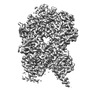



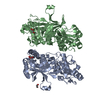

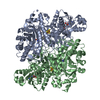
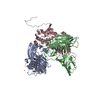
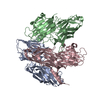

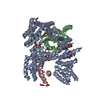
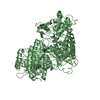
 Z (Sec.)
Z (Sec.) Y (Row.)
Y (Row.) X (Col.)
X (Col.)





















